Business & Business Environment Report: SMEs, Functions, and Structure
VerifiedAdded on 2021/01/01
|9
|2510
|454
Report
AI Summary
This report provides a comprehensive overview of the business environment, exploring various organizational types, including public, private, and voluntary sectors, and their respective legal structures such as sole traders, partnerships, and private limited companies. It delves into the characteristics of micro, small, and medium-sized enterprises (SMEs), outlining their purposes, objectives, and the goods and services they supply. The report further examines the size and scope of different organizations, analyzing the interrelationship between organizational functions like marketing, finance, human resource management, and operations, and how these functions are linked to organizational objectives and structures. It also discusses the advantages and disadvantages of these interrelationships, highlighting their impact on organizational structures, and concludes with a summary of the key findings and references.
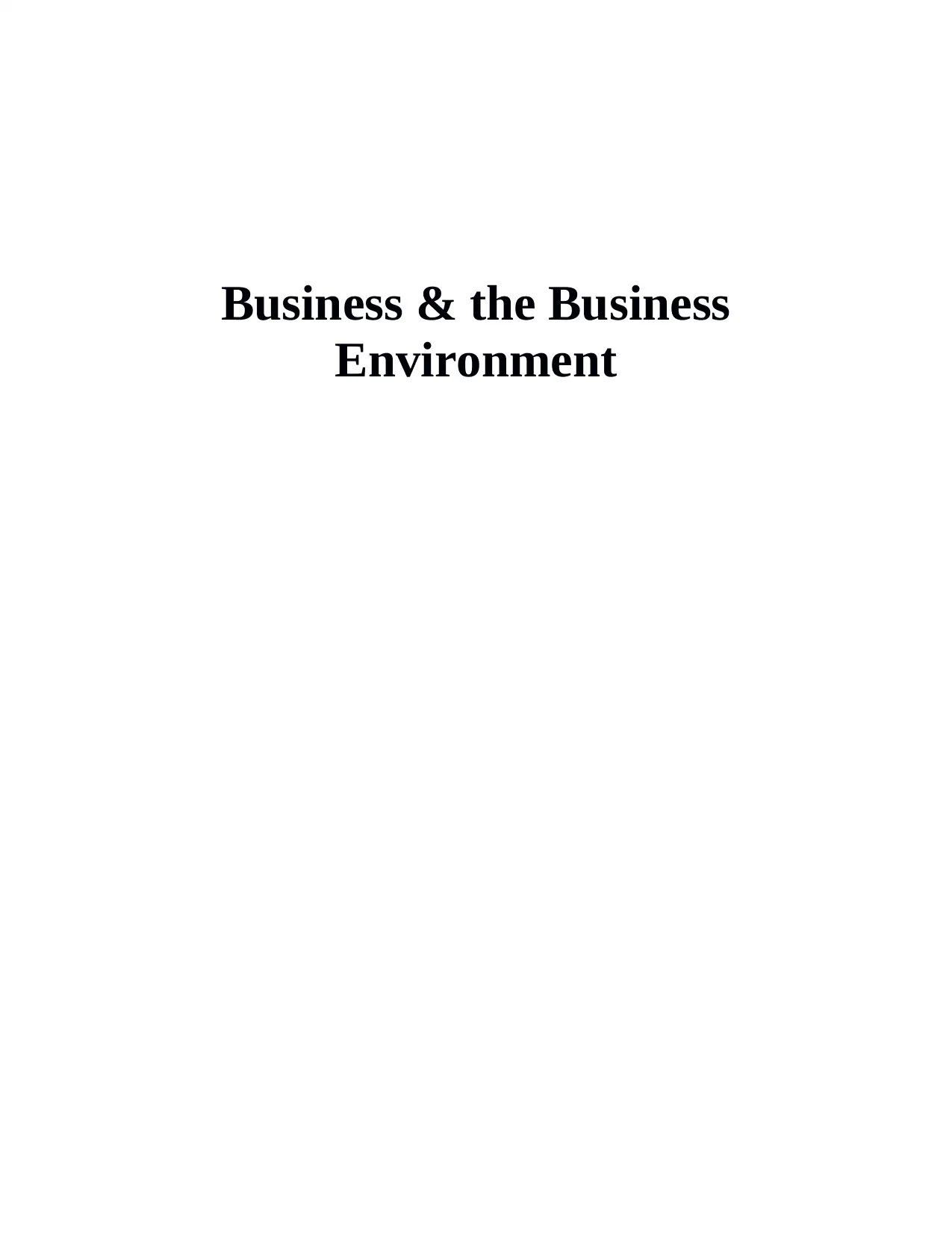
Business & the Business
Environment
Environment
Paraphrase This Document
Need a fresh take? Get an instant paraphrase of this document with our AI Paraphraser
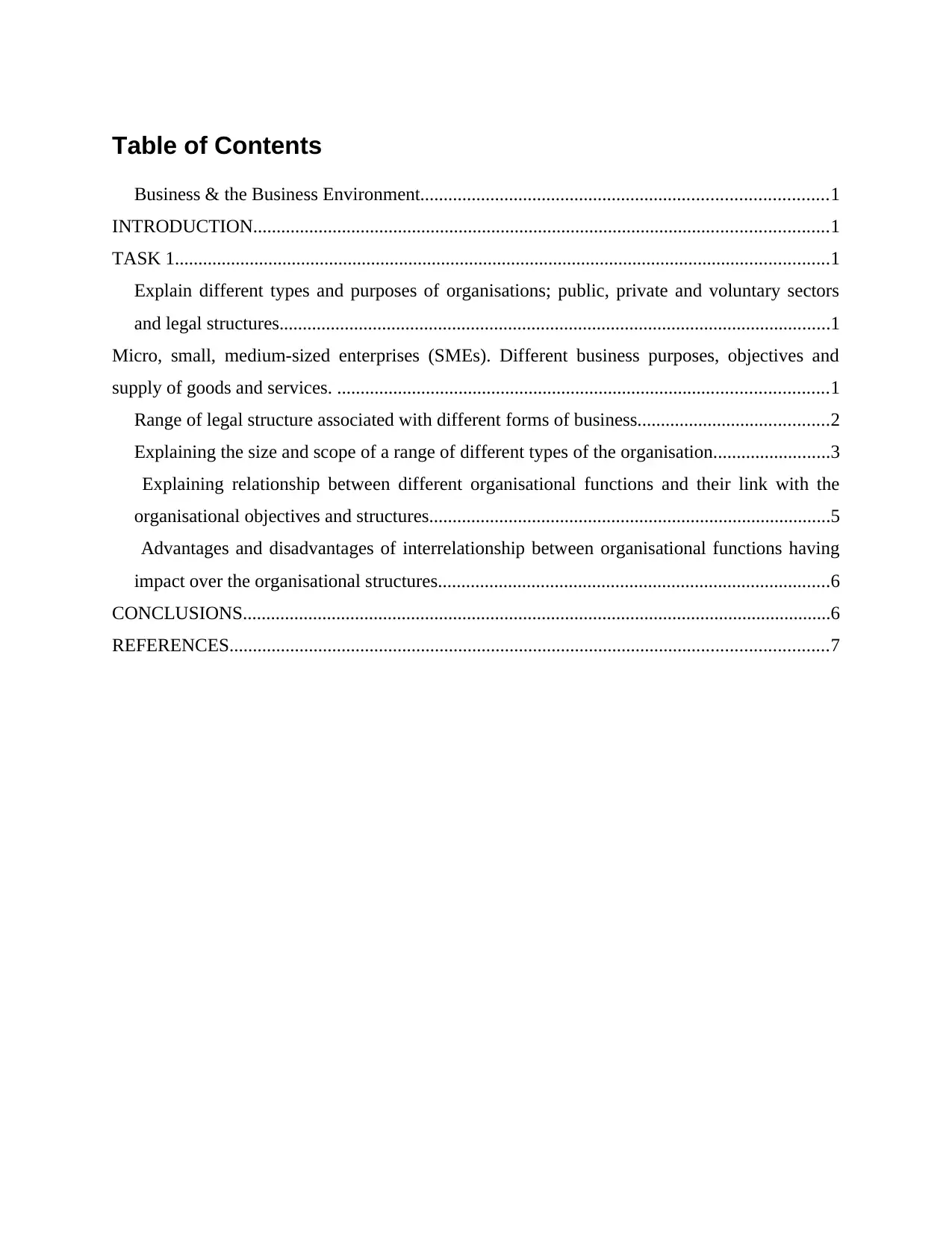
Table of Contents
Business & the Business Environment.......................................................................................1
INTRODUCTION...........................................................................................................................1
TASK 1............................................................................................................................................1
Explain different types and purposes of organisations; public, private and voluntary sectors
and legal structures......................................................................................................................1
Micro, small, medium-sized enterprises (SMEs). Different business purposes, objectives and
supply of goods and services. .........................................................................................................1
Range of legal structure associated with different forms of business.........................................2
Explaining the size and scope of a range of different types of the organisation.........................3
Explaining relationship between different organisational functions and their link with the
organisational objectives and structures......................................................................................5
Advantages and disadvantages of interrelationship between organisational functions having
impact over the organisational structures....................................................................................6
CONCLUSIONS..............................................................................................................................6
REFERENCES................................................................................................................................7
Business & the Business Environment.......................................................................................1
INTRODUCTION...........................................................................................................................1
TASK 1............................................................................................................................................1
Explain different types and purposes of organisations; public, private and voluntary sectors
and legal structures......................................................................................................................1
Micro, small, medium-sized enterprises (SMEs). Different business purposes, objectives and
supply of goods and services. .........................................................................................................1
Range of legal structure associated with different forms of business.........................................2
Explaining the size and scope of a range of different types of the organisation.........................3
Explaining relationship between different organisational functions and their link with the
organisational objectives and structures......................................................................................5
Advantages and disadvantages of interrelationship between organisational functions having
impact over the organisational structures....................................................................................6
CONCLUSIONS..............................................................................................................................6
REFERENCES................................................................................................................................7
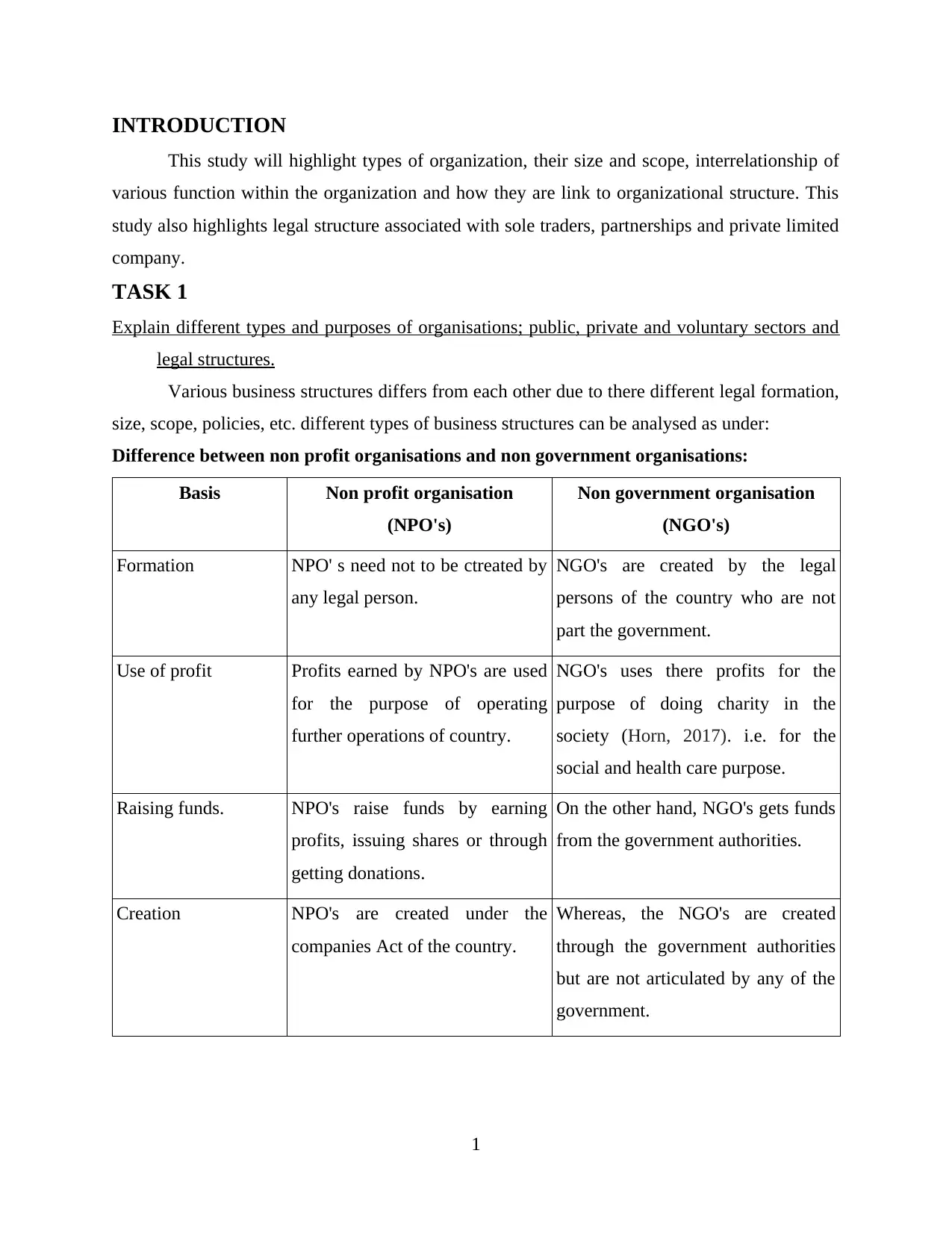
INTRODUCTION
This study will highlight types of organization, their size and scope, interrelationship of
various function within the organization and how they are link to organizational structure. This
study also highlights legal structure associated with sole traders, partnerships and private limited
company.
TASK 1
Explain different types and purposes of organisations; public, private and voluntary sectors and
legal structures.
Various business structures differs from each other due to there different legal formation,
size, scope, policies, etc. different types of business structures can be analysed as under:
Difference between non profit organisations and non government organisations:
Basis Non profit organisation
(NPO's)
Non government organisation
(NGO's)
Formation NPO' s need not to be ctreated by
any legal person.
NGO's are created by the legal
persons of the country who are not
part the government.
Use of profit Profits earned by NPO's are used
for the purpose of operating
further operations of country.
NGO's uses there profits for the
purpose of doing charity in the
society (Horn, 2017). i.e. for the
social and health care purpose.
Raising funds. NPO's raise funds by earning
profits, issuing shares or through
getting donations.
On the other hand, NGO's gets funds
from the government authorities.
Creation NPO's are created under the
companies Act of the country.
Whereas, the NGO's are created
through the government authorities
but are not articulated by any of the
government.
1
This study will highlight types of organization, their size and scope, interrelationship of
various function within the organization and how they are link to organizational structure. This
study also highlights legal structure associated with sole traders, partnerships and private limited
company.
TASK 1
Explain different types and purposes of organisations; public, private and voluntary sectors and
legal structures.
Various business structures differs from each other due to there different legal formation,
size, scope, policies, etc. different types of business structures can be analysed as under:
Difference between non profit organisations and non government organisations:
Basis Non profit organisation
(NPO's)
Non government organisation
(NGO's)
Formation NPO' s need not to be ctreated by
any legal person.
NGO's are created by the legal
persons of the country who are not
part the government.
Use of profit Profits earned by NPO's are used
for the purpose of operating
further operations of country.
NGO's uses there profits for the
purpose of doing charity in the
society (Horn, 2017). i.e. for the
social and health care purpose.
Raising funds. NPO's raise funds by earning
profits, issuing shares or through
getting donations.
On the other hand, NGO's gets funds
from the government authorities.
Creation NPO's are created under the
companies Act of the country.
Whereas, the NGO's are created
through the government authorities
but are not articulated by any of the
government.
1
⊘ This is a preview!⊘
Do you want full access?
Subscribe today to unlock all pages.

Trusted by 1+ million students worldwide
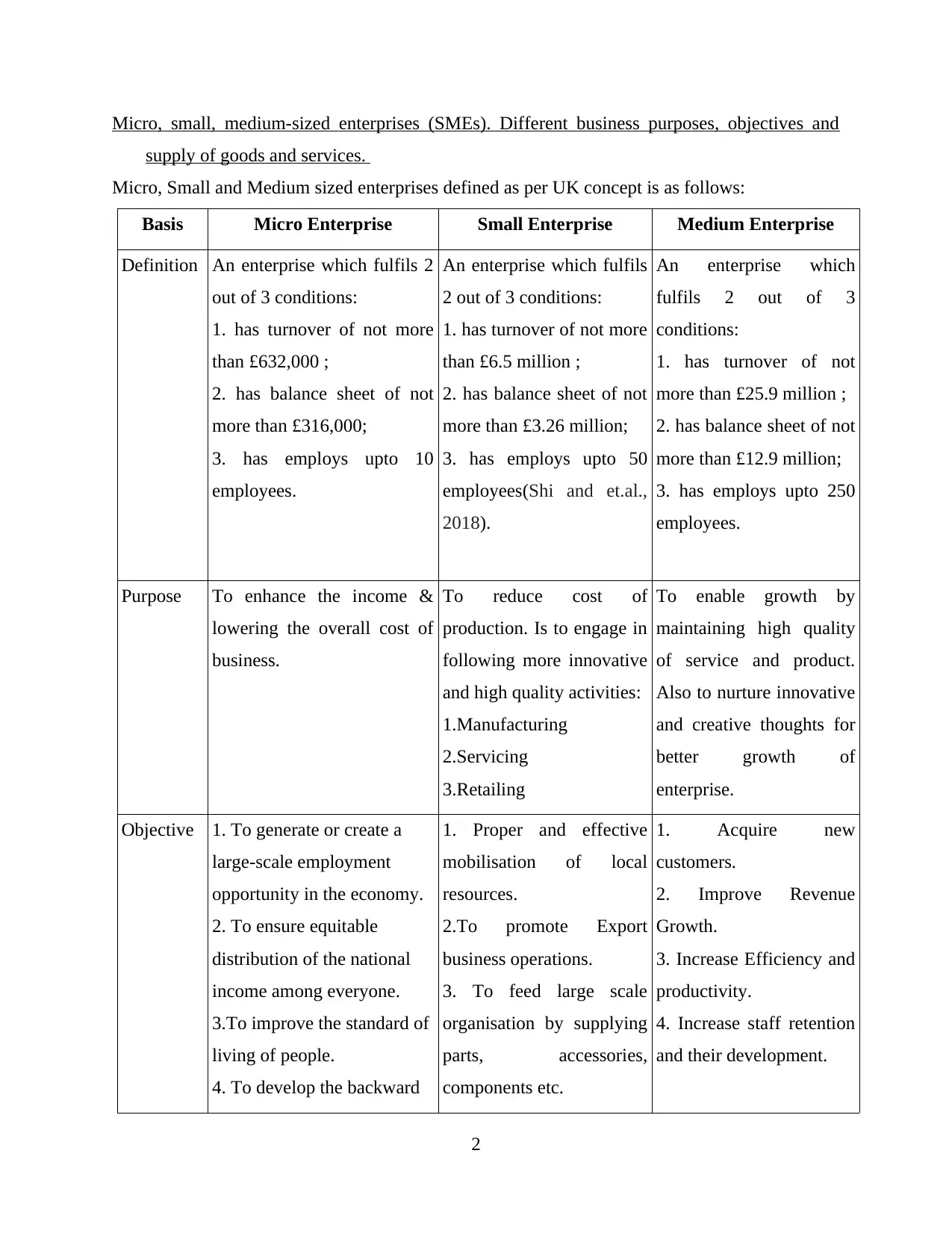
Micro, small, medium-sized enterprises (SMEs). Different business purposes, objectives and
supply of goods and services.
Micro, Small and Medium sized enterprises defined as per UK concept is as follows:
Basis Micro Enterprise Small Enterprise Medium Enterprise
Definition An enterprise which fulfils 2
out of 3 conditions:
1. has turnover of not more
than £632,000 ;
2. has balance sheet of not
more than £316,000;
3. has employs upto 10
employees.
An enterprise which fulfils
2 out of 3 conditions:
1. has turnover of not more
than £6.5 million ;
2. has balance sheet of not
more than £3.26 million;
3. has employs upto 50
employees(Shi and et.al.,
2018).
An enterprise which
fulfils 2 out of 3
conditions:
1. has turnover of not
more than £25.9 million ;
2. has balance sheet of not
more than £12.9 million;
3. has employs upto 250
employees.
Purpose To enhance the income &
lowering the overall cost of
business.
To reduce cost of
production. Is to engage in
following more innovative
and high quality activities:
1.Manufacturing
2.Servicing
3.Retailing
To enable growth by
maintaining high quality
of service and product.
Also to nurture innovative
and creative thoughts for
better growth of
enterprise.
Objective 1. To generate or create a
large-scale employment
opportunity in the economy.
2. To ensure equitable
distribution of the national
income among everyone.
3.To improve the standard of
living of people.
4. To develop the backward
1. Proper and effective
mobilisation of local
resources.
2.To promote Export
business operations.
3. To feed large scale
organisation by supplying
parts, accessories,
components etc.
1. Acquire new
customers.
2. Improve Revenue
Growth.
3. Increase Efficiency and
productivity.
4. Increase staff retention
and their development.
2
supply of goods and services.
Micro, Small and Medium sized enterprises defined as per UK concept is as follows:
Basis Micro Enterprise Small Enterprise Medium Enterprise
Definition An enterprise which fulfils 2
out of 3 conditions:
1. has turnover of not more
than £632,000 ;
2. has balance sheet of not
more than £316,000;
3. has employs upto 10
employees.
An enterprise which fulfils
2 out of 3 conditions:
1. has turnover of not more
than £6.5 million ;
2. has balance sheet of not
more than £3.26 million;
3. has employs upto 50
employees(Shi and et.al.,
2018).
An enterprise which
fulfils 2 out of 3
conditions:
1. has turnover of not
more than £25.9 million ;
2. has balance sheet of not
more than £12.9 million;
3. has employs upto 250
employees.
Purpose To enhance the income &
lowering the overall cost of
business.
To reduce cost of
production. Is to engage in
following more innovative
and high quality activities:
1.Manufacturing
2.Servicing
3.Retailing
To enable growth by
maintaining high quality
of service and product.
Also to nurture innovative
and creative thoughts for
better growth of
enterprise.
Objective 1. To generate or create a
large-scale employment
opportunity in the economy.
2. To ensure equitable
distribution of the national
income among everyone.
3.To improve the standard of
living of people.
4. To develop the backward
1. Proper and effective
mobilisation of local
resources.
2.To promote Export
business operations.
3. To feed large scale
organisation by supplying
parts, accessories,
components etc.
1. Acquire new
customers.
2. Improve Revenue
Growth.
3. Increase Efficiency and
productivity.
4. Increase staff retention
and their development.
2
Paraphrase This Document
Need a fresh take? Get an instant paraphrase of this document with our AI Paraphraser
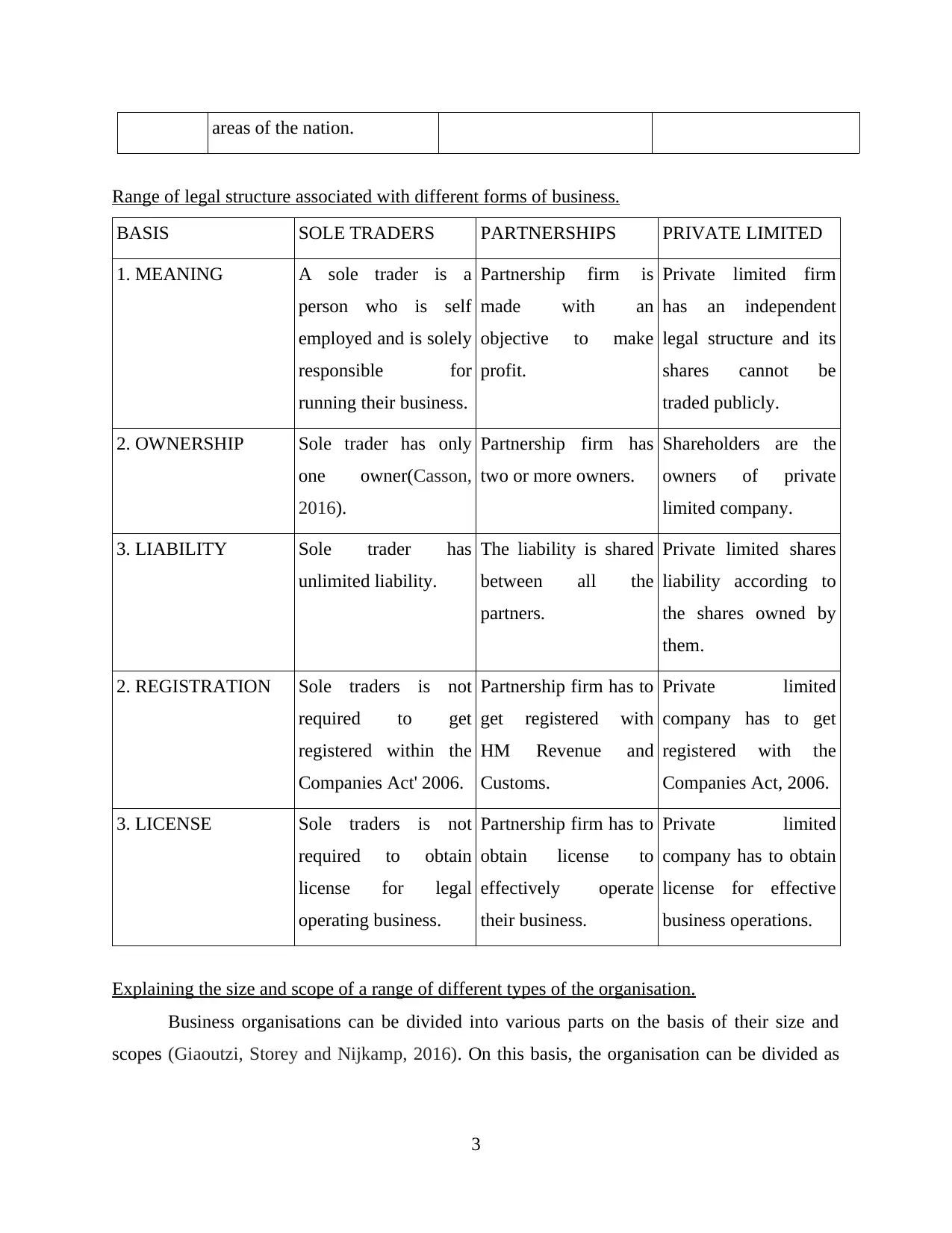
areas of the nation.
Range of legal structure associated with different forms of business.
BASIS SOLE TRADERS PARTNERSHIPS PRIVATE LIMITED
1. MEANING A sole trader is a
person who is self
employed and is solely
responsible for
running their business.
Partnership firm is
made with an
objective to make
profit.
Private limited firm
has an independent
legal structure and its
shares cannot be
traded publicly.
2. OWNERSHIP Sole trader has only
one owner(Casson,
2016).
Partnership firm has
two or more owners.
Shareholders are the
owners of private
limited company.
3. LIABILITY Sole trader has
unlimited liability.
The liability is shared
between all the
partners.
Private limited shares
liability according to
the shares owned by
them.
2. REGISTRATION Sole traders is not
required to get
registered within the
Companies Act' 2006.
Partnership firm has to
get registered with
HM Revenue and
Customs.
Private limited
company has to get
registered with the
Companies Act, 2006.
3. LICENSE Sole traders is not
required to obtain
license for legal
operating business.
Partnership firm has to
obtain license to
effectively operate
their business.
Private limited
company has to obtain
license for effective
business operations.
Explaining the size and scope of a range of different types of the organisation.
Business organisations can be divided into various parts on the basis of their size and
scopes (Giaoutzi, Storey and Nijkamp, 2016). On this basis, the organisation can be divided as
3
Range of legal structure associated with different forms of business.
BASIS SOLE TRADERS PARTNERSHIPS PRIVATE LIMITED
1. MEANING A sole trader is a
person who is self
employed and is solely
responsible for
running their business.
Partnership firm is
made with an
objective to make
profit.
Private limited firm
has an independent
legal structure and its
shares cannot be
traded publicly.
2. OWNERSHIP Sole trader has only
one owner(Casson,
2016).
Partnership firm has
two or more owners.
Shareholders are the
owners of private
limited company.
3. LIABILITY Sole trader has
unlimited liability.
The liability is shared
between all the
partners.
Private limited shares
liability according to
the shares owned by
them.
2. REGISTRATION Sole traders is not
required to get
registered within the
Companies Act' 2006.
Partnership firm has to
get registered with
HM Revenue and
Customs.
Private limited
company has to get
registered with the
Companies Act, 2006.
3. LICENSE Sole traders is not
required to obtain
license for legal
operating business.
Partnership firm has to
obtain license to
effectively operate
their business.
Private limited
company has to obtain
license for effective
business operations.
Explaining the size and scope of a range of different types of the organisation.
Business organisations can be divided into various parts on the basis of their size and
scopes (Giaoutzi, Storey and Nijkamp, 2016). On this basis, the organisation can be divided as
3
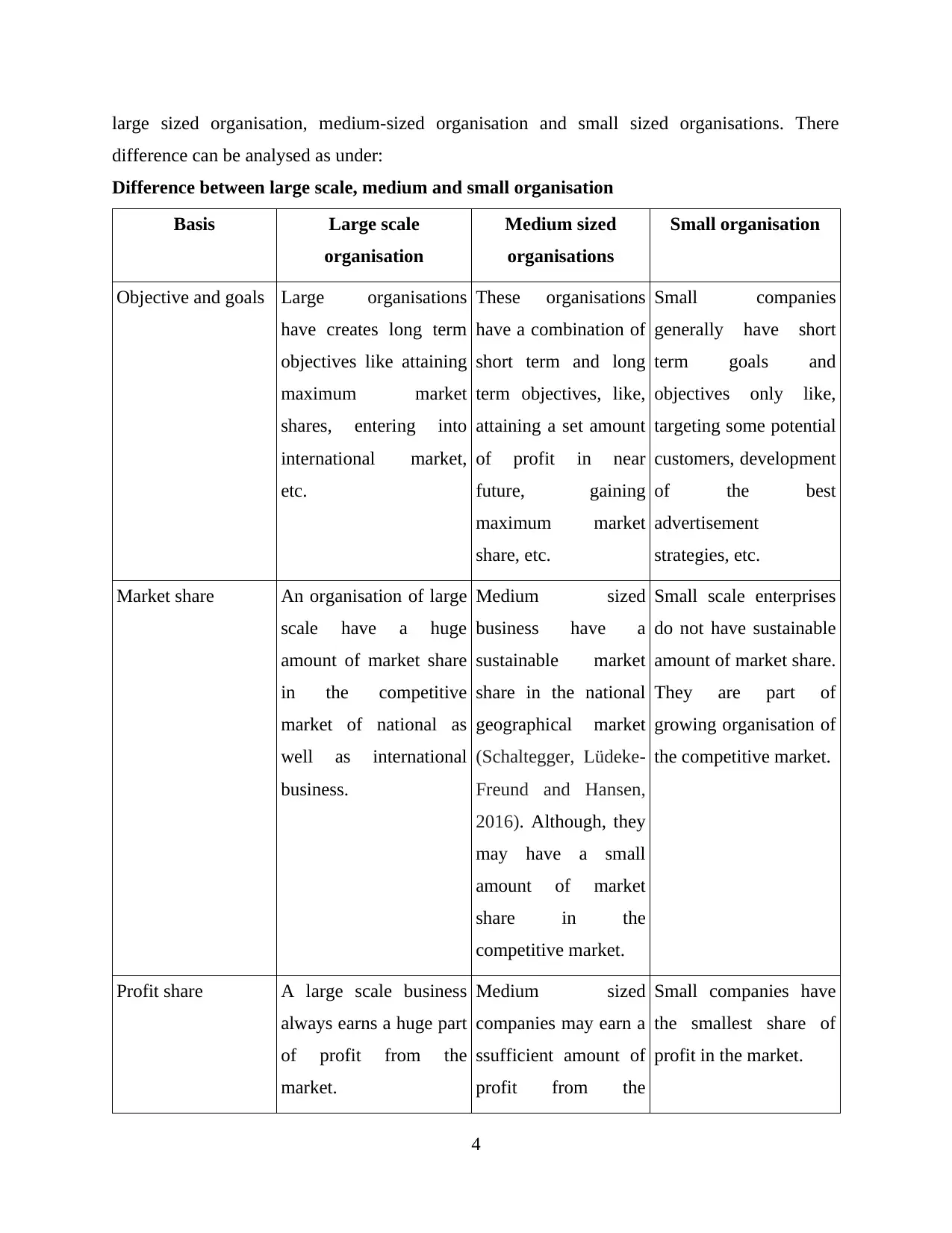
large sized organisation, medium-sized organisation and small sized organisations. There
difference can be analysed as under:
Difference between large scale, medium and small organisation
Basis Large scale
organisation
Medium sized
organisations
Small organisation
Objective and goals Large organisations
have creates long term
objectives like attaining
maximum market
shares, entering into
international market,
etc.
These organisations
have a combination of
short term and long
term objectives, like,
attaining a set amount
of profit in near
future, gaining
maximum market
share, etc.
Small companies
generally have short
term goals and
objectives only like,
targeting some potential
customers, development
of the best
advertisement
strategies, etc.
Market share An organisation of large
scale have a huge
amount of market share
in the competitive
market of national as
well as international
business.
Medium sized
business have a
sustainable market
share in the national
geographical market
(Schaltegger, Lüdeke-
Freund and Hansen,
2016). Although, they
may have a small
amount of market
share in the
competitive market.
Small scale enterprises
do not have sustainable
amount of market share.
They are part of
growing organisation of
the competitive market.
Profit share A large scale business
always earns a huge part
of profit from the
market.
Medium sized
companies may earn a
ssufficient amount of
profit from the
Small companies have
the smallest share of
profit in the market.
4
difference can be analysed as under:
Difference between large scale, medium and small organisation
Basis Large scale
organisation
Medium sized
organisations
Small organisation
Objective and goals Large organisations
have creates long term
objectives like attaining
maximum market
shares, entering into
international market,
etc.
These organisations
have a combination of
short term and long
term objectives, like,
attaining a set amount
of profit in near
future, gaining
maximum market
share, etc.
Small companies
generally have short
term goals and
objectives only like,
targeting some potential
customers, development
of the best
advertisement
strategies, etc.
Market share An organisation of large
scale have a huge
amount of market share
in the competitive
market of national as
well as international
business.
Medium sized
business have a
sustainable market
share in the national
geographical market
(Schaltegger, Lüdeke-
Freund and Hansen,
2016). Although, they
may have a small
amount of market
share in the
competitive market.
Small scale enterprises
do not have sustainable
amount of market share.
They are part of
growing organisation of
the competitive market.
Profit share A large scale business
always earns a huge part
of profit from the
market.
Medium sized
companies may earn a
ssufficient amount of
profit from the
Small companies have
the smallest share of
profit in the market.
4
⊘ This is a preview!⊘
Do you want full access?
Subscribe today to unlock all pages.

Trusted by 1+ million students worldwide
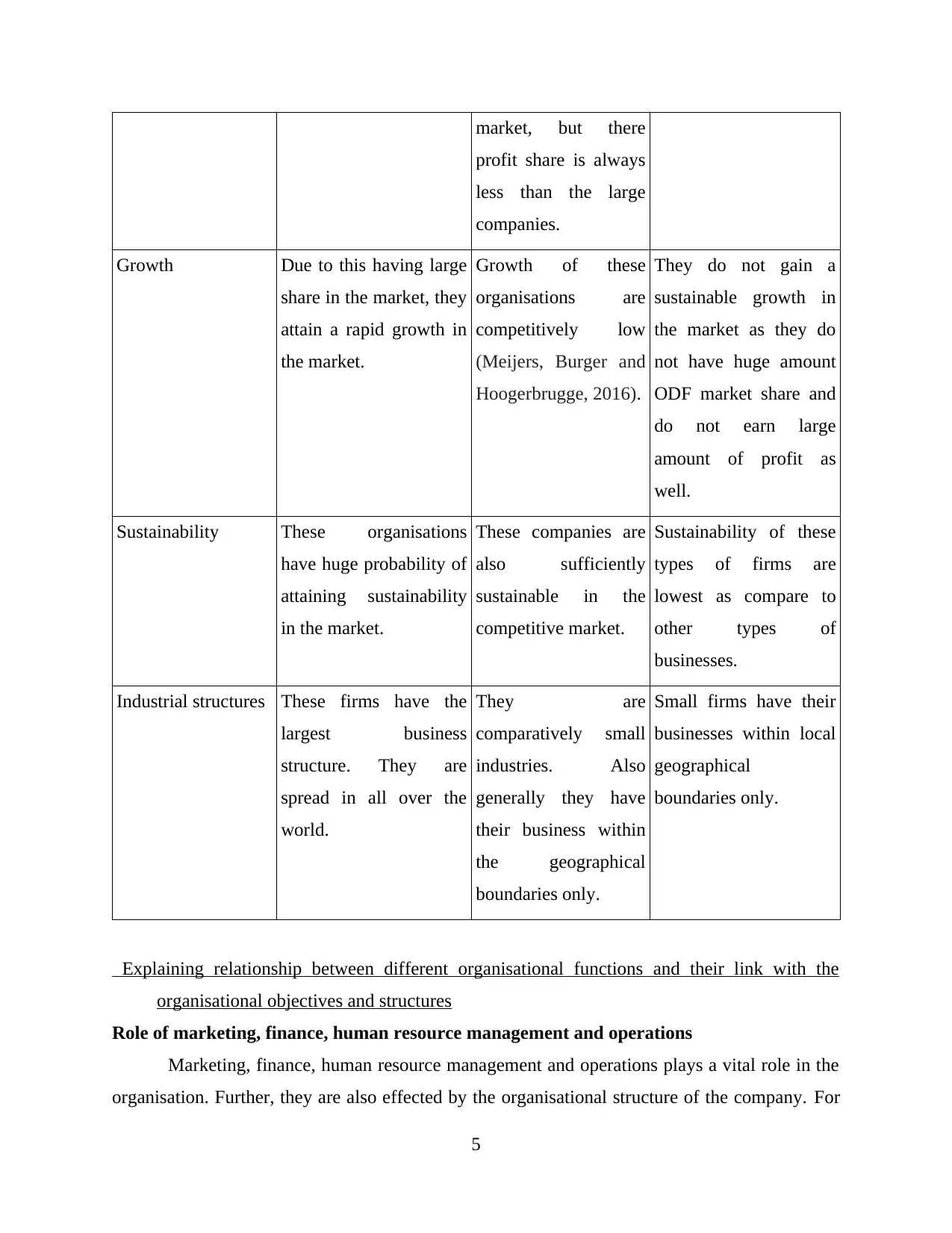
market, but there
profit share is always
less than the large
companies.
Growth Due to this having large
share in the market, they
attain a rapid growth in
the market.
Growth of these
organisations are
competitively low
(Meijers, Burger and
Hoogerbrugge, 2016).
They do not gain a
sustainable growth in
the market as they do
not have huge amount
ODF market share and
do not earn large
amount of profit as
well.
Sustainability These organisations
have huge probability of
attaining sustainability
in the market.
These companies are
also sufficiently
sustainable in the
competitive market.
Sustainability of these
types of firms are
lowest as compare to
other types of
businesses.
Industrial structures These firms have the
largest business
structure. They are
spread in all over the
world.
They are
comparatively small
industries. Also
generally they have
their business within
the geographical
boundaries only.
Small firms have their
businesses within local
geographical
boundaries only.
Explaining relationship between different organisational functions and their link with the
organisational objectives and structures
Role of marketing, finance, human resource management and operations
Marketing, finance, human resource management and operations plays a vital role in the
organisation. Further, they are also effected by the organisational structure of the company. For
5
profit share is always
less than the large
companies.
Growth Due to this having large
share in the market, they
attain a rapid growth in
the market.
Growth of these
organisations are
competitively low
(Meijers, Burger and
Hoogerbrugge, 2016).
They do not gain a
sustainable growth in
the market as they do
not have huge amount
ODF market share and
do not earn large
amount of profit as
well.
Sustainability These organisations
have huge probability of
attaining sustainability
in the market.
These companies are
also sufficiently
sustainable in the
competitive market.
Sustainability of these
types of firms are
lowest as compare to
other types of
businesses.
Industrial structures These firms have the
largest business
structure. They are
spread in all over the
world.
They are
comparatively small
industries. Also
generally they have
their business within
the geographical
boundaries only.
Small firms have their
businesses within local
geographical
boundaries only.
Explaining relationship between different organisational functions and their link with the
organisational objectives and structures
Role of marketing, finance, human resource management and operations
Marketing, finance, human resource management and operations plays a vital role in the
organisation. Further, they are also effected by the organisational structure of the company. For
5
Paraphrase This Document
Need a fresh take? Get an instant paraphrase of this document with our AI Paraphraser
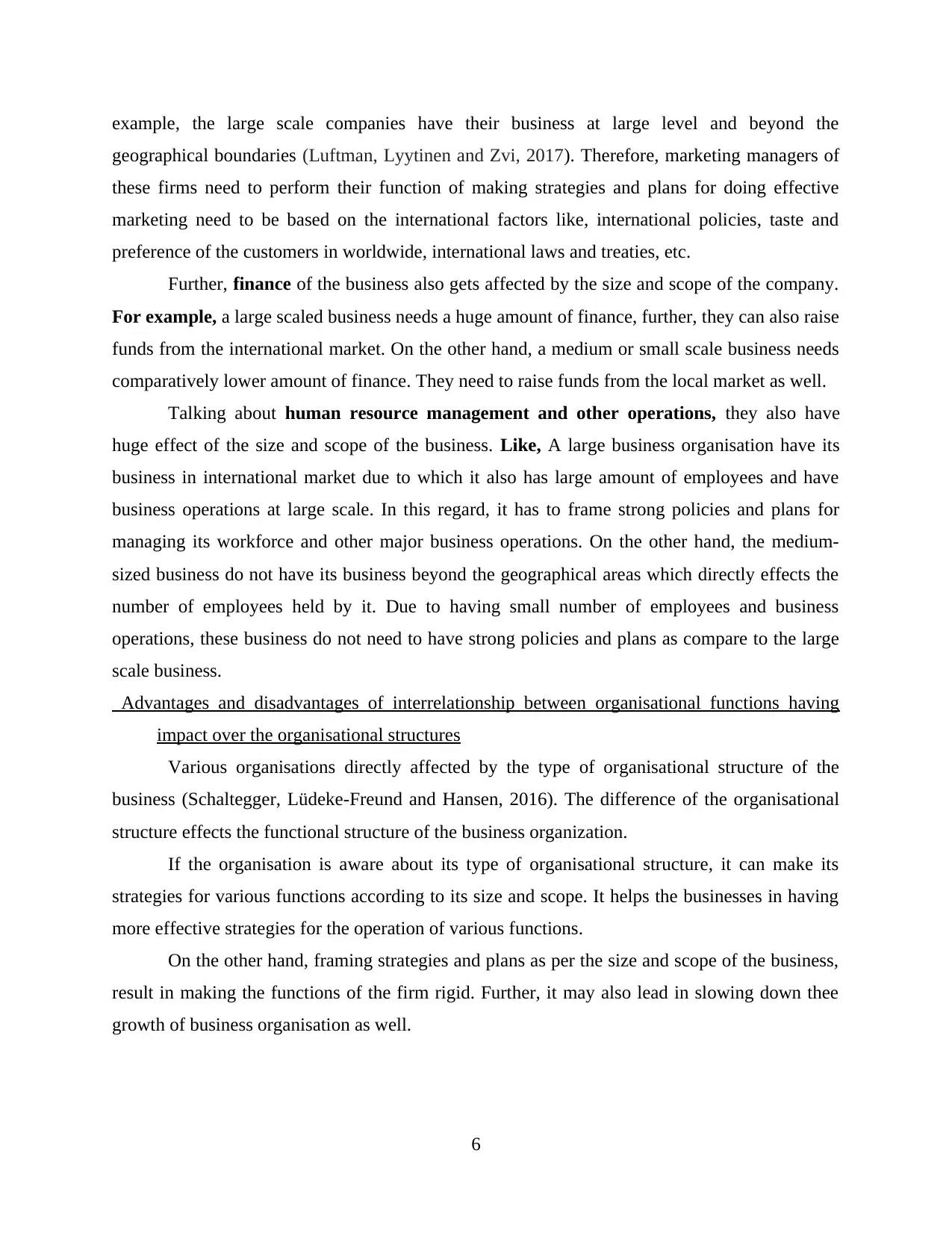
example, the large scale companies have their business at large level and beyond the
geographical boundaries (Luftman, Lyytinen and Zvi, 2017). Therefore, marketing managers of
these firms need to perform their function of making strategies and plans for doing effective
marketing need to be based on the international factors like, international policies, taste and
preference of the customers in worldwide, international laws and treaties, etc.
Further, finance of the business also gets affected by the size and scope of the company.
For example, a large scaled business needs a huge amount of finance, further, they can also raise
funds from the international market. On the other hand, a medium or small scale business needs
comparatively lower amount of finance. They need to raise funds from the local market as well.
Talking about human resource management and other operations, they also have
huge effect of the size and scope of the business. Like, A large business organisation have its
business in international market due to which it also has large amount of employees and have
business operations at large scale. In this regard, it has to frame strong policies and plans for
managing its workforce and other major business operations. On the other hand, the medium-
sized business do not have its business beyond the geographical areas which directly effects the
number of employees held by it. Due to having small number of employees and business
operations, these business do not need to have strong policies and plans as compare to the large
scale business.
Advantages and disadvantages of interrelationship between organisational functions having
impact over the organisational structures
Various organisations directly affected by the type of organisational structure of the
business (Schaltegger, Lüdeke-Freund and Hansen, 2016). The difference of the organisational
structure effects the functional structure of the business organization.
If the organisation is aware about its type of organisational structure, it can make its
strategies for various functions according to its size and scope. It helps the businesses in having
more effective strategies for the operation of various functions.
On the other hand, framing strategies and plans as per the size and scope of the business,
result in making the functions of the firm rigid. Further, it may also lead in slowing down thee
growth of business organisation as well.
6
geographical boundaries (Luftman, Lyytinen and Zvi, 2017). Therefore, marketing managers of
these firms need to perform their function of making strategies and plans for doing effective
marketing need to be based on the international factors like, international policies, taste and
preference of the customers in worldwide, international laws and treaties, etc.
Further, finance of the business also gets affected by the size and scope of the company.
For example, a large scaled business needs a huge amount of finance, further, they can also raise
funds from the international market. On the other hand, a medium or small scale business needs
comparatively lower amount of finance. They need to raise funds from the local market as well.
Talking about human resource management and other operations, they also have
huge effect of the size and scope of the business. Like, A large business organisation have its
business in international market due to which it also has large amount of employees and have
business operations at large scale. In this regard, it has to frame strong policies and plans for
managing its workforce and other major business operations. On the other hand, the medium-
sized business do not have its business beyond the geographical areas which directly effects the
number of employees held by it. Due to having small number of employees and business
operations, these business do not need to have strong policies and plans as compare to the large
scale business.
Advantages and disadvantages of interrelationship between organisational functions having
impact over the organisational structures
Various organisations directly affected by the type of organisational structure of the
business (Schaltegger, Lüdeke-Freund and Hansen, 2016). The difference of the organisational
structure effects the functional structure of the business organization.
If the organisation is aware about its type of organisational structure, it can make its
strategies for various functions according to its size and scope. It helps the businesses in having
more effective strategies for the operation of various functions.
On the other hand, framing strategies and plans as per the size and scope of the business,
result in making the functions of the firm rigid. Further, it may also lead in slowing down thee
growth of business organisation as well.
6

CONCLUSIONS
From the above study it has been summarized that there are various business organization like
profit, non profit, NGO, small, medium and large enterprises, sole trader, partnership firm and
limited liability with different organisational size, structure and scope.
7
From the above study it has been summarized that there are various business organization like
profit, non profit, NGO, small, medium and large enterprises, sole trader, partnership firm and
limited liability with different organisational size, structure and scope.
7
⊘ This is a preview!⊘
Do you want full access?
Subscribe today to unlock all pages.

Trusted by 1+ million students worldwide
1 out of 9
Related Documents
Your All-in-One AI-Powered Toolkit for Academic Success.
+13062052269
info@desklib.com
Available 24*7 on WhatsApp / Email
![[object Object]](/_next/static/media/star-bottom.7253800d.svg)
Unlock your academic potential
Copyright © 2020–2025 A2Z Services. All Rights Reserved. Developed and managed by ZUCOL.




